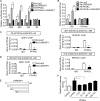Inhibition of gluconeogenic genes by calcium-regulated heat-stable protein 1 via repression of peroxisome proliferator-activated receptor α
- PMID: 21990353
- PMCID: PMC3220516
- DOI: 10.1074/jbc.M111.232918
Inhibition of gluconeogenic genes by calcium-regulated heat-stable protein 1 via repression of peroxisome proliferator-activated receptor α
Abstract
Gluconeogenesis contributes to insulin resistance in type 1 and type 2 diabetes, but its regulation and the underlying molecular mechanisms remain unclear. Recently, calcium-regulated heat-stable protein 1 (CARHSP1) was identified as a biomarker for diabetic complications. In this study, we investigated the role of CARHSP1 in hepatic gluconeogenesis. We assessed the regulation of hepatic CARHSP1 expression under conditions of fasting and refeeding. Adenovirus-mediated CARHSP1 overexpression and siRNA-mediated knockdown experiments were performed to characterize the role of CARHSP1 in the regulation of gluconeogenic gene expression. Here, we document for the first time that CARHSP1 is regulated by nutrient status in the liver and functions at the transcriptional level to negatively regulate gluconeogenic genes, including the glucose-6-phosphatase catalytic subunit (G6Pc) and phosphoenolpyruvate carboxykinase 1 (PEPCK1). In addition, we found that CARHSP1 can physically interact with peroxisome proliferator-activated receptor-α (PPARα) and inhibit its transcriptional activity. Both pharmacological and genetic ablations of PPARα attenuate the inhibitory effect of CARHSP1 on gluconeogenic gene expression in hepatocytes. Our data suggest that CARHSP1 inhibits hepatic gluconeogenic gene expression via repression of PPARα and that CARHSP1 may be a molecular target for the treatment of diabetes.
Figures









Similar articles
-
Zbtb7c is a critical gluconeogenic transcription factor that induces glucose-6-phosphatase and phosphoenylpyruvate carboxykinase 1 genes expression during mice fasting.Biochim Biophys Acta Gene Regul Mech. 2019 Jun;1862(6):643-656. doi: 10.1016/j.bbagrm.2019.04.001. Epub 2019 Apr 5. Biochim Biophys Acta Gene Regul Mech. 2019. PMID: 30959128
-
The SMILE transcriptional corepressor inhibits cAMP response element-binding protein (CREB)-mediated transactivation of gluconeogenic genes.J Biol Chem. 2018 Aug 24;293(34):13125-13133. doi: 10.1074/jbc.RA118.002196. Epub 2018 Jun 27. J Biol Chem. 2018. PMID: 29950523 Free PMC article.
-
DAX-1 acts as a novel corepressor of orphan nuclear receptor HNF4alpha and negatively regulates gluconeogenic enzyme gene expression.J Biol Chem. 2009 Oct 2;284(40):27511-23. doi: 10.1074/jbc.M109.034660. Epub 2009 Aug 3. J Biol Chem. 2009. PMID: 19651776 Free PMC article.
-
Regulation of hepatic gluconeogenesis by nuclear factor Y transcription factor in mice.J Biol Chem. 2018 May 18;293(20):7894-7904. doi: 10.1074/jbc.RA117.000508. Epub 2018 Mar 12. J Biol Chem. 2018. PMID: 29530977 Free PMC article.
-
Peroxisome proliferator-activated receptor {alpha} is responsible for the up-regulation of hepatic glucose-6-phosphatase gene expression in fasting and db/db Mice.J Biol Chem. 2011 Jan 14;286(2):1157-64. doi: 10.1074/jbc.M110.157875. Epub 2010 Nov 16. J Biol Chem. 2011. PMID: 21081500 Free PMC article.
Cited by
-
Relationships of Non-coding RNA with diabetes and depression.Sci Rep. 2019 Jul 24;9(1):10707. doi: 10.1038/s41598-019-47077-9. Sci Rep. 2019. PMID: 31341180 Free PMC article.
-
Curcumin Treatment Identifies Therapeutic Targets within Biomarkers of Liver Colonization by Highly Invasive Mesothelioma Cells-Potential Links with Sarcomas.Cancers (Basel). 2020 Nov 16;12(11):3384. doi: 10.3390/cancers12113384. Cancers (Basel). 2020. PMID: 33207594 Free PMC article.
-
Perhexiline activates KLF14 and reduces atherosclerosis by modulating ApoA-I production.J Clin Invest. 2015 Oct 1;125(10):3819-30. doi: 10.1172/JCI79048. Epub 2015 Sep 14. J Clin Invest. 2015. PMID: 26368306 Free PMC article.
-
Genome-wide CRISPR/Cas9 screening identifies CARHSP1 responsible for radiation resistance in glioblastoma.Cell Death Dis. 2021 Jul 21;12(8):724. doi: 10.1038/s41419-021-04000-3. Cell Death Dis. 2021. PMID: 34290231 Free PMC article.
-
Krüppel-like factor-11, a transcription factor involved in diabetes mellitus, suppresses endothelial cell activation via the nuclear factor-κB signaling pathway.Arterioscler Thromb Vasc Biol. 2012 Dec;32(12):2981-8. doi: 10.1161/ATVBAHA.112.300349. Epub 2012 Oct 4. Arterioscler Thromb Vasc Biol. 2012. PMID: 23042817 Free PMC article.
References
-
- Boden G., Chen X., Stein T. P. (2001) Am. J. Physiol. Endocrinol. Metab. 280, E23–30 - PubMed
-
- Perriello G., Pampanelli S., Del Sindaco P., Lalli C., Ciofetta M., Volpi E., Santeusanio F., Brunetti P., Bolli G. B. (1997) Diabetes 46, 1010–1016 - PubMed
-
- Wajngot A., Chandramouli V., Schumann W. C., Ekberg K., Jones P. K., Efendic S., Landau B. R. (2001) Metabolism 50, 47–52 - PubMed
-
- Biddinger S. B., Kahn C. R. (2006) Annu. Rev. Physiol. 68, 123–158 - PubMed
-
- Quinn P. G., Yeagley D. (2005) Curr. Drug Targets Immune Endocr. Metabol. Disord. 5, 423–437 - PubMed
Publication types
MeSH terms
Substances
Grants and funding
LinkOut - more resources
Full Text Sources
Molecular Biology Databases
Research Materials
Miscellaneous

